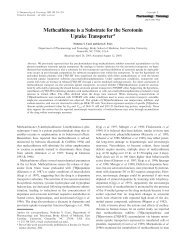STATEMENT OF NICHOLAS V
STATEMENT OF NICHOLAS V
STATEMENT OF NICHOLAS V
You also want an ePaper? Increase the reach of your titles
YUMPU automatically turns print PDFs into web optimized ePapers that Google loves.
24. Frankenheim Section II. 9. c. is obvious fear-mongering and completely specious; bacteria and fungi<br />
are ubiquitous in the environment and one could say the same of any plant such as dried oregano or<br />
dried flowers.<br />
25. Frankenheim Section II. 10. repeatedly attempts to link Daime with the unrelated drug, LSD.<br />
26. Frankenheim Section II. 11. displays more purely speculative fear-mongering by Dr. Frankenheim as<br />
for example: "In other words, increasing the ayahuasca dose (for example, doubling it, or, for another<br />
example, "stacking" doses (i.e., taking a second dose before the effects of the first dose have<br />
completely waned)) may yield a greater-than-expected amount of DMT in the brain and greater-thanexpected<br />
consequences. This is purely hypothetical. One could suggest that anyone may consume<br />
more of anything to yield a greater-than-expected consequence. Water intoxication is well-known to<br />
produce unintended fatalities.<br />
27. Frankenheim Section II. 12. a. ii. Dr. Frankenheim states that "Though the harmala alkaloids are<br />
"reversible" inhibitors of MAO . . . their sojourn in the human body lasts much longer than that of the<br />
DMT (Riba, et.aI., 2003)". This is incorrect; actually, the harmala alkaloids responsible for the bulk<br />
of MAO inhibitory activity in Daime (harmine and harmaline) return to baseline (i.e. "zero") within<br />
6-8 hours, paralleling the presence of DMT in the human body (Yritia et al., 2002; Riba et al., 2003).<br />
Other harmala alkaloids found in Daime are only weak inhibitors of MAO (Buckholtz and Boggan,<br />
1977).<br />
28. MAO exists in two forms, termed MAO-A and MAO-B. The MAO enzymes metabolize many<br />
thousands of substances including the trace amine tyramine. Tyramine is a simple arylamine, namely<br />
4-hydroxyphenethylamine. Tyramine is found in many foods including wine, beer, sherry, aged<br />
cheese, yeast extract, protein extract, soy sauce, fava or broad bean pods, smoked poultry, meats, and<br />
fish (lox, smoked salmon), pickled poultry, meats, and fish (pickled herring), chicken livers,<br />
fermented sausage (bologna, pepperoni, salami, summer sausage) and other fermented meats,<br />
bananas, avocados, and over-ripe fruit. Tyramine has the ability to release norepinephrine, leading to<br />
an increase in blood pressure and heart rate. In high amounts, tyramine can produce a potentially<br />
fatal hypertensive crisis characterized by hypertension, tachycardia, severe headache, fever, and<br />
mydriasis. Normally, MAO metabolizes and deactivates the tyramine in foods before it can be<br />
systemically absorbed, thereby avoiding the potential problems associated with too much tyramine.<br />
About 50% of tyramine is deactivated by MAO-A and the rest is metabolized by MAO-B and other<br />
metabolic enzymes (Morin et al., 2002). Earlier antidepressant drugs (e.g. tranylcypromine,<br />
phenylzine) were nonselective, irreversible inhibitors of MAO; these drugs inhibit both MAO-A and<br />
MAO-B and they do so irreversibly. The MAO enzymes are permanently inactivated (at least until<br />
the cells synthesized fresh MAO), and patients taking these drugs are unable to metabolize the<br />
dangerous tyramine. For this reason, they must avoid the foods listed above.<br />
29. The harmala alkaloids in Daime differ from the early antidepressants in that they are both selective<br />
and reversible inhibitors of MAO. The harmala alkaloids are selective for MAO-A, thus, MAO-B is<br />
still available to function as normal and degrade tyramine. The reversible aspect of the harmala<br />
alkaloids means that they do not permanently bind to and inactivate the MAO-A enzyme, as the early<br />
antidepressants do. The harmala alkaloids bind, unbind, bind, unbind, and so on in a dynamic<br />
process. When the MAO-A is in the unbound state, it is free to metabolize tyramine. Thus, if a<br />
problematic molecule such as tyramine is present, the MAO-A still has a chance to deactivate it, and<br />
the MAO-B and other tyramine-metabolizing enzymes are still available to deactivate it as well.<br />
30. Like the harmala compounds found in Daime, the antidepressant drug moclobemide is also a selective<br />
and reversible inhibitor of the MAO-A isozyme. Significantly, moclobemide has a negligible



